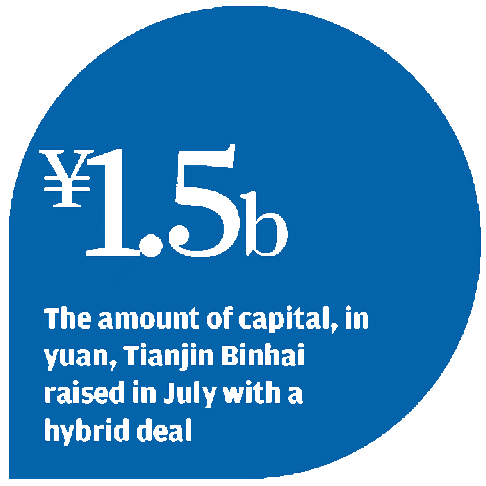
China banks seen issuing hybrid debt to cope with bad loans, boost capital
Mainland lenders seen issuing more debt that can convert to equity, force losses onto investors

In the dark days of July, as investors digested news of China's growth slowdown and grappled with an interbank market liquidity squeeze, Tianjin Binhai Rural Commercial Bank quietly raised 1.5 billion yuan (HK$1.9 billion) in new capital.

It was telling that the mid-sized domestic deal for a second-string issuer involved two bulge-bracket brokerages - the domestic securities arms of Credit Suisse and Goldman Sachs.
The banks were testing a hybrid instrument that will become the workhorse for recapitalising China's banks, a looming trillion-yuan-plus initiative unfolding over the next three to five years.
"This is important to recapitalisation. It represents a new generation of instruments for issuers and a new pool of assets for investors," said Dominique Jooris, the head of credit capital markets, Asia ex-Japan, for Goldman Sachs.
Hybrids are securities that mix debt and equity features.
The terms of hybrid deals spell out the risk of loss investors in the products face. The Tianjin Binhai deal includes a clause that lets the regulator force investors to take losses if it deems the issuer no longer viable.
In the past, the mainland banks issued subordinated bonds and investors assumed that the mainland government backed the deals. That meant investors disregarded the structure and ranking of the debt as they assumed the government would always bail out the banks if they got into trouble, according to Bin Hu, a banking analyst at ratings agency Moody's.
The history of mainland banking is littered with bailouts. In the early to mid-2000s, state-owned holding company Huijin spent US$60 billion to recapitalise China Construction Bank, Bank of China and Industrial and Commercial Bank of China. The government has used an estimated US$200 billion recapitalising banks over past decades.
Fast forward to today and mainland banks need more cash again, partly to protect against losses on non-performing loans but mostly to keep pace with a rapid growth in lending.
Ratings agency Fitch projects that the Big Four state-owned banks will add US$1 trillion in assets this year and that the country's banks had piled on US$14 trillion in assets since 2009.
That does not include off-balance sheet items, such as trade finance and wealth management products, an accounting of which, Fitch estimates, will double banks' assets.
As the banks expand their lending bases, they need to add regulatory capital to cushion against losses.
Meanwhile, as mainland economic growth slows, banks cannot rely on stellar profits as an internal source of cash to fund expansion.
"They need a market solution," says Hu.
Beijing wants to give the recapitalisation job to the market. Enter the next-generation hybrid. The China Banking Regulatory Commission approved the instrument in December 2012 to upgrade China's hybrid standards in line with Basel III. At its essence, Basel III applies the lessons of the 2008-2009 global financial crisis to ensure governments and taxpayers will not be forced to bail out banks again.
Regulators have redesigned the instrument to make it easier to force losses onto investors.
"China adopted Basel III by the book. It was a straight implementation of the rules," said Frank Kwong, the head of syndicate Asia, fixed income, at BNP Paribas.
The Tianjin Binhai deal is the first iteration of this new hybrid. It will be widely replicated because banks will have to use the instrument to refinance all existing subordinated debt, which makes up most of their tier-2 capital.
"The new hybrids will be rolled out as China's subordinated bonds mature - it's a lot of issuance," said Kwong.
Meanwhile, the Tianjin Binhai hybrid paves the way for a radical new instrument for mainland banks - the non-equity tier-one hybrid.
Tier-1 capital is banks' ultimate defence against failure. Regulators view this capital as the most fundamental measure of a bank's health. Mainland banks have never issued hybrids to fund their tier-1 capital but they are now talking to the CBRC about using the new rules to do such a thing.
Agricultural Bank of China said in an April 26 stock exchange announcement that it was looking to raise up to 40 billion yuan of tier-1 capital through issuance of hybrid securities. The bank is also eyeing a 50 billion yuan tier-2 hybrid that will have the same write-down mechanism as the Tianjin Binhai deal. ICBC and CCB are looking to raise 50 billion to 60 billion yuan with hybrids to boost tier one and two capital, Wu said.
Banks like the new hybrid because it counts towards tier-1 without the dilution of voting rights and earnings that comes with equity issuance.
Given that mainland banks are starting from zero, the potential for issuance of non-equity tier-1s is vast. ICBC's tier-1 capital is US$160 billion. Jooris of Goldman Sachs said global banks on average held 15 per cent of their tier-1 capital in the form of hybrids. If ICBC wanted to adopt that average, that bank alone would need to raise US$24 billion.
It's a potentially massive wave of issuance that will roll through the market, shaking up investors, bank shareholders, bookrunners and banks. It's a big deal, and it started with Tianjin Binhai Rural Commercial Bank.